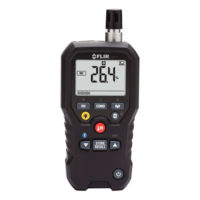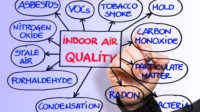Modern buildings rely heavily on technology to achieve their performance goals, but they generate reams of system data that often go unused. Building performance monitoring and metrics (BPMM) is a new tool that that compiles building data into a few useful metrics to help operators understand whether their building technology is working as intended. By deploying BPMM, designers can provide easily accessible building performance information such as energy consumption by end use (lighting, heating, air conditioning, elevators, etc.) building demand, and system performance information to building operators with minimal additional cost to a new construction project.
BPMM applies to the whole building and to major systems. Whole-building information allows operators to understand their building performance over time and compare it to other buildings. System-level information helps operators better understand how and why their buildings use energy to meet the operating requirements. Rapid increases in computing capacity have given building management control systems the capability to affordably monitor HVAC equipment and system performance. BPMM condenses this large quantity of system data into a series of indicators and compares them to benchmarks, thereby helping building operators continuously tune their building’s systems to balance comfort and energy efficiency. In this article, we’ll explain BPMM, focusing primarily on HVAC system-level BPMM and provide a high-level view of other building metrics.
WHY SYSTEM-LEVEL BPMM?
As an industry, we provide building operators with efficient HVAC systems as well as powerful BAS to control the building and its HVAC equipment. What we don’t give the operators is a roadmap that lets them see where they are going. Building operators typically receive minimal training on how to control building systems and how to perform basic equipment maintenance. Given these limited tools, operators are expected to run high-tech HVAC equipment optimally to provide comfort most efficiently.
Operators need to understand the equivalent MPG for their HVAC systems and they need to know the target. Delivering comfort efficiently requires the operator to have direct access to information about system and equipment operating efficiencies. Providing system efficiency information in a useful manner allows operators to make system changes in response to comfort problems and immediately see the impact on energy consumption. The expectations for operational efficiency are implicit, but without BPMM, the tools and basic information for building performance management are lacking.
We have directly experienced the impact of feedback influencing operation after purchasing late-model cars that provide real time MPG and advertise very high fuel efficiency. When we are in a rush and drive with a lead foot, our MPG plummets. But, when we drive conservatively, we are able to realize an impressive improvement in the car’s gas mileage. Real-time feedback teaches us how to drive more efficiently, and it doesn’t prevent us from hitting the accelerator when more power is needed.
If we apply this concept to buildings, providing operators with useful information that is easy to see and read (not rafts of trend reports but a single metric demonstrating efficiency), we will enable them to manage building system energy use and comfort at the same time. Most buildings operators receive direct feedback about comfort and no feedback about energy use. Providing the operator with a more complete picture through BPMM will enable them to do a better job of delivering comfort efficiently.
CURRENT STATE OF AFFAIRS
In HVAC design practice, the effective application of performance monitoring technologies is currently behind the availability of such technologies in the marketplace. Over the last decade, we have conducted well over a hundred design reviews and we have yet to see a designer call for VFD motor kW display on the BAS graphic panels.
- Why is it important to provide this information?
Including the motor kW on the DDC graphic display enables building operators to immediately see the ramifications of a well-intentioned setpoint change (static pressure, supply air temperature, etc.).
- Isn’t adding system-level BPMM expensive?
It’s actually inexpensive to provide BPMM since every VFD has a “free” built-in kW meter. There is little or no incremental cost when kW is imported into the BAS using protocols such as BACnet and the cost for kW acquisition and reporting via I/O wiring is only the additional cost much to run an extra set of low voltage conductors.
- Will operators have capacity to look at the data?
The concept behind BPMM is to provide simple system metrics, like MPG, making it easy for operators to understand performance on a real-time basis.
Application of BPMM at the HVAC system level is very new. Energy-efficiency programs, which are often focused on helping increase the adoption of new efficiency technologies into the market, are just now beginning to offer incentives for BPMM systems. Design firms are unfamiliar with the design and specifications of these systems, but within five years we expect these systems to be commonplace. Today, most global and many smaller companies have sustainability goals (Environmental Leader, 2012), and BPMM tools will help companies track and manage their progress toward these goals. In addition, we expect to see rapid adoption of the tools as early success stories of building and campus sustainability, such as the University of California’s Merced Campus experience with BPMM (Mercado and Elliott, 2012), are recognized.
BPMM FOR HVAC SYSTEMS
The following provides basic guidance about the data acquisition (monitoring) and benchmarks (metrics) that we recommend for building HVAC systems. We address what to monitor and display, and how to establish useful metrics. The recommendations we provide for benchmark metrics are based on highly energy efficient design. Older buildings may be unable to achieve the levels of performance cited and might aim for lower performance goals, but new buildings should be designed and operated to achieve and even surpass these metrics.
We have developed these metrics to provide numbers at a meaningful scale to building operators. We recommend standardizing on common units of electric power (W and kW) since we purchase energy based on kilowatt-hours of consumption and kilowatts of peak demand. Structuring metrics to have commonality will improve their use. For instance, it will allow operators to learn firsthand that it is much more efficient to deliver heating or cooling using water than it is using air. This will empower operators to tune their buildings accordingly and may affect their decisionmaking about alterations down the road.
AIR-HANDLING SYSTEMS
Air-handling system performance can be quantified by both electric demand (kW) and energy input (kWh) per cfm of air supplied by the unit. These two key data points provide the basis for understanding and optimizing air handler performance.
Provide meaningful performance metrics which, for central VAV air handlers, would be watts per 1,000 cfm (W/kcfm). Obtaining this information is simple: sum the dynamic (supply and return fan) kW and divide by thousands of cfm supply air volume. Most VAV air handlers have supply airflow measurement stations to capture supply flow. If not, the next best option is to sum the terminal VAV box airflows. The equation follows:
ASHRAE 90.1 limits the power consumption of VAV air handlers to a maximum of 970 W/kcfm (1.3 bhp/kcfm). In our experience, correctly sized and operating VAV systems can deliver a system efficiency of 550 W/kcfm or better. In addition, specify that fan kW be shown next to the fans on the BAS air handler graphic display.
HYDRONIC SYSTEMS
Similar to fans, for pumps we can measure energy demand and energy use per unit of flow, in this case per gallon of fluid per minute (gpm). Again, displaying the kW adjacent to the pump on the BAS graphic is informative. If the system has a flow meter provide a metric of W/100 gpm. The formula is:
This approach allows operators to observe how pump head pressure impacts power use. A variable flow system with a pump efficiency of 70%, 60 ft of head pressure, and a 20 ft differential pressure control setpoint has a full load design power of 1,900 W/100 gpm.1 At 50% part load operation maintaining the 20 feet of differential control setpoint, the pump power drops to only 475 W/100 gpm.
COOLING PLANTS
Cooling plant performance should be expressed as kW per ton, as is typically reported by cooling plant equipment manufacturers. We recommend providing tiers of information for cooling plants because of the highly interactive effects of set point changes on multiple pieces of equipment within the cooling plant. For example, by increasing the temperature of the chilled water supply by 1.0°F, compressor power is reduced by about 0.01 kW per ton for centrifugal chillers (Thomas Hartman 2007).
Establishing the load on the cooling plant requires a Btu meter. To provide the most useful information, it is preferable to provide a Btu meter on each chiller. Btu meters can be installed for around $5,000. Providing operators with actual real-time flow data will help them control energy costs, monitor and manage peak consumption and assist them in fault detection and diagnostics.
Provide true kW (rather than using the readily available chiller amps) due to power factor and variations in actual line voltage. Provide a dedicated power meter on each chiller networked directly into the BAS. These meters cost about $2,500 installed. Because we recommend a number of metrics for cooling plants, we have detailed them in Table 1.
For variable-speed auxiliary equipment, typically chilled water pumps, condenser pumps and cooling tower fans, capture the VFD kW. The VFD kW meters are typically located downstream of the VFD electronics and do not account for VFD efficiency losses. Divide the VFD kW by VFD efficiency, which, depending on motor size, range from around 0.95% for smaller motors (<25 hp) to approximately 0.97% for larger motors. The auxiliary equipment kW/ton value is often surprisingly high. As chiller efficiency increases, the impacts of the auxiliary equipment are larger; these impacts have historically been overlooked because they were unobserved and perceived to be a small component of plant energy use.
For constant speed equipment such as condenser filtration rigs or constant speed pumps, measure true kW using a field true kW power meter and assign this value within the BMS. Account for this power when the BMS status indicates the equipment is on.
OTHER IMPORTANT METRICS
In addition to HVAC metrics that can be incorporated into the BAS for minimal cost, there are other important metrics that can help building operators manage building performance and energy use. For lighting, we recommend the building total lighting watts/sq ft and cumulative lighting kWh/sq ft In addition, whole building metrics help operators and management understand the big picture. For these we recommend reporting building annual energy performance measured in terms of average total building annual kBtu/sq ft/yr. The total annual kBtuh/sq ft/yrenergy consumption for the building should be normalized to typical weather so that building performance for different years can be compared. This provides the total building MPG equivalent.
We recently commissioned a community college educational facility with high operating hours which achieved LEED® Gold certification and has operated at a normalized 49 kBtuh/sq ft/yr, and another LEED Gold light manufacturing facility that is operating at a normalized level of 19 kBtuh/sq ft/yr. According to CBECS (U.S. Department of Energy, 2003) the average commercial building in the northeast averages around kBtuh/sq ft/yr so these buildings are clearly operating very efficiently. The more familiar our industry becomes with what is achievable and what we are actually achieving with our energy efficient designs in practice, the more likely we are to set and achieve higher goals for building energy performance.
EMPOWERING BUILDING OPERATORS
Providing performance metrics empowers operators to manage their systems and buildings for efficiency and to achieve continuing improvement. In addition to providing real-time feedback about system adjustments, BPMM can help operators answer questions they may have, such as:
- How do my air handlers compare?
- Am I using what is expected?
- Has anything changed?
- Am I improving over time?
Building performance metrics align with corporate lean management and operations goals, as well as with corporate sustainability goals. By establishing metrics and monitoring progress, BPMM enables measured assessment of progress towards goals and provides evidence of continuous improvement. Companies can develop incentive structures that reward operators for optimized operations.
Without these tools, building energy use typically increases over time; in other words, investments in energy efficiency lose value both as the equipment depreciates and also as unchecked equipment performance deteriorates.
REAL-WORLD ANSWERS
Building simulation is often used to determine the impacts of efficiency improvements. We’ve read statements in technical publications such as, “We determined static pressure reset on a VAV air handler cut fan power energy use by 30% using building simulation modeling.” BPMM enables us to measure the actual impacts and monitor them over time to ensure performance is maintained. This approach costs less and is more accurate than building simulations.
Building performance metrics help to identify high users in the building and enable immediate feedback when efficiency strategies, such as static pressure set point reset or changing to cog type fan belts, are implemented. BPMM allows operators to “try out” an efficiency measure on a single piece of equipment, see how it performs, and make an informed decision about adoption across the facility. BPMM also supports Continuous Commissioning®2 in which building operators identify deficiencies, improve them and monitor the results, ensuring constant improvement over time.
Another benefit is the ability to document pre- and post-energy savings from retrocommissioning projects. The need for complex calculations and assumptions is reduced because performance metrics provide real world, believable answers. This facilitates validation of savings for energy efficiency programs, improving rebates because program administrators have increased confidence in the reliability and persistence of the savings.
COMMISSIONING BUILDING PERFORMANCE METRICS
Building commissioning is the independent verification of equipment, controls, and their operations. For BPMM, the commissioning service provider validates the reported values through the commissioning process. The importance of accurate, “believable” data is critical to the success of BPMM.
In commissioning performance monitoring systems, we have not found a single reported kW value that was accurate when first tested. In one case, we found a chiller kW power transducer with a current transformer (CT) programmed for the incorrect CT size; this resulted in values that were 18% off from actual. In several cases, we have found erroneous kW values imported from the VFD into the BAS. Btu meters are frequently installed out of compliance the manufacturer requirement for straight pipe upstream and downstream, resulting in decreased device accuracy due to turbulence.
A thorough, independent commissioning process identifies issues with the BPMM system and ensures that the reported values are accurate and displayed in a useful format.
CONCLUSION
BPMM gives operators the tools they need to understand and optimize their buildings. It transforms the business as usual scenario from continuous degradation of system efficiency with increasing energy costs to continuous improvement of system and operator performance. We all have a role to play:
-
Project designers need to include fundamental performance monitoring and metrics in their control sequences;
-
Building owners need to engage with the information and recognize continuous improvement
-
Building operators need to use the information to improve their understanding of their building systems so that they can institute improvements on an ongoing basis.
Isn’t this really management 101? “We cannot manage what we do not measure.”
FOOTNOTES
-
Pump at 70% efficiency, 95% VFD efficiency, 89.5% motor efficiency.
-
Continuous Commissioning® is a registered trademark of the Texas A&M Engineering Experiment Station, a member of the Texas A&M University System, an agency of the state of Texas.
WORKS CITED
-
http://www.environmentalleader.com/2012/09/19/nearly-50-of-cfos-say-sustainability-is-key-driver-of-financial-performance/ (accessed November 27, 2012).
-
Erpelding, P.E., Ben. HPAC Engineering. July 15, 2008. http://hpac.com/fastrack/Erpelding-VSD/(accessed November 27, 2012).
-
Mercado, Andrea, and John Elliott. “Energy Performance Platform: Revealing and Maintaining Efficiency With a Customized Energy Information System.” 2012 ACEEE Summer Study on Energy Efficiency in Buildings. Pacific Grove, CA: ACEEE, 2012.
-
Hartman, P.E., Thomas “Sustainable Chilled Water Systems.” 44th Annual Conference and Technical Exhibition.New Orleans, LA: ASHE, 2007.
-
U.S. Department of Energy. Commercial Building Energy Consumption Survey. Survey, U.S. Department of Energy, 2003.







